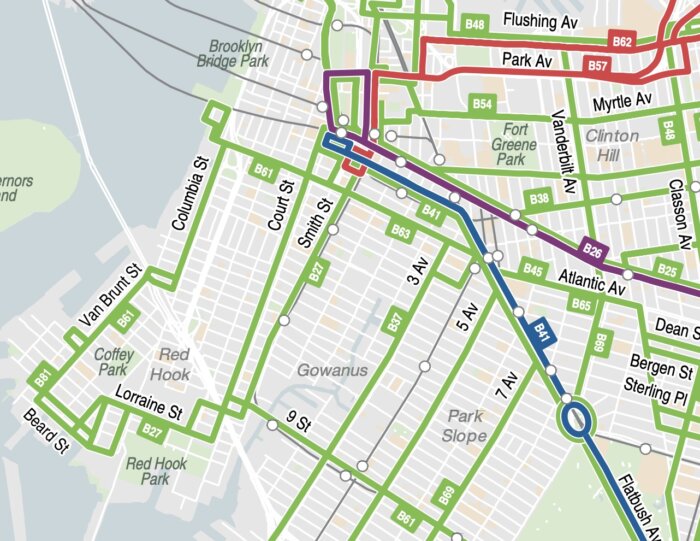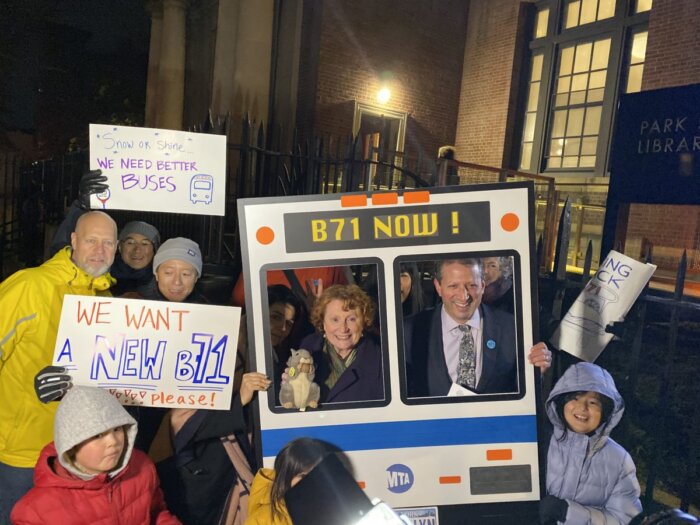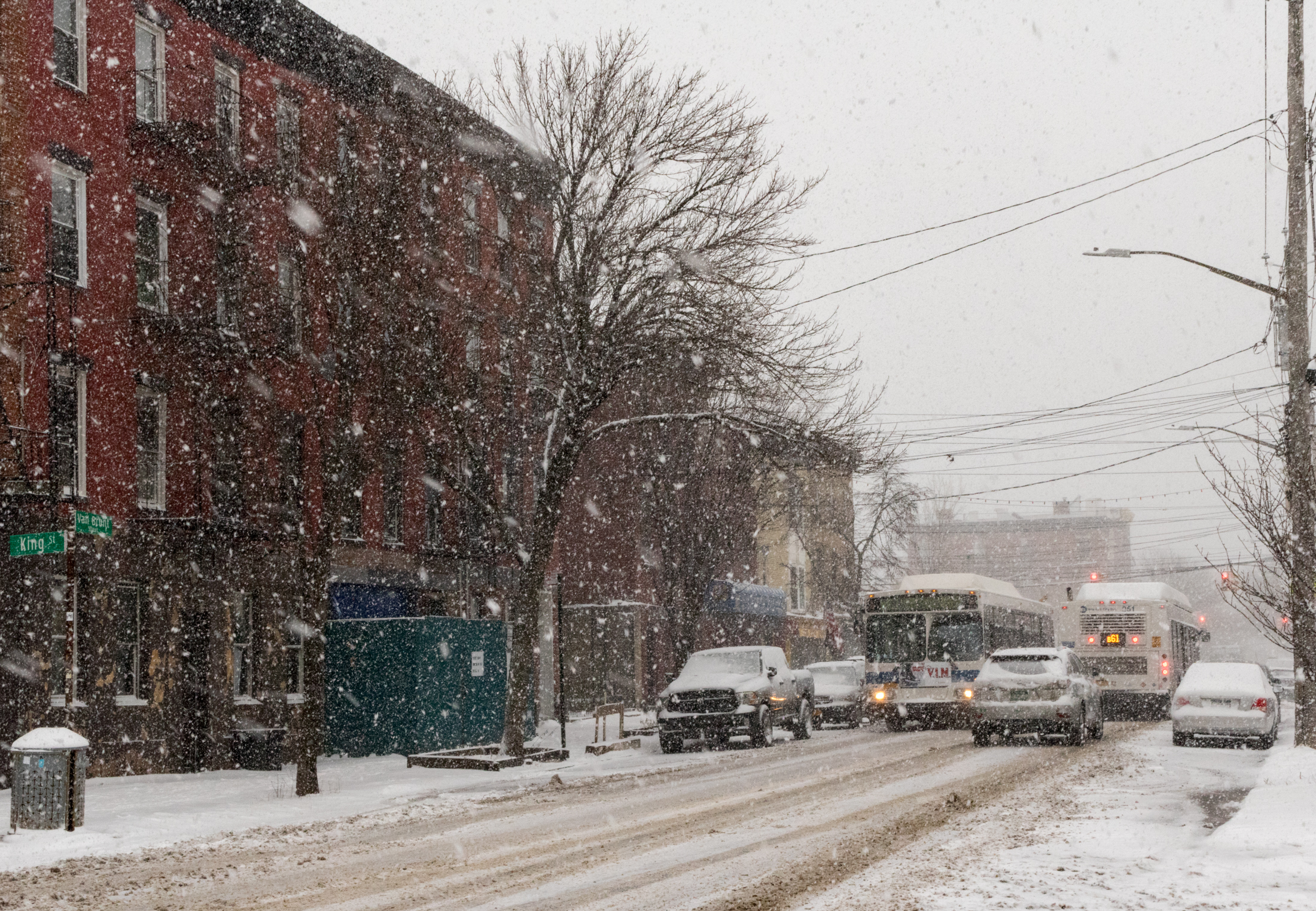Brooklynites Ask MTA to Revive B71 in Brooklyn Bus Redesign
As the Metropolitan Transportation Authority prepares the Brooklyn Bus Network Redesign, western and central Brooklyn locals want to revive a long-dead bus line.

Central and western Brooklynites want the MTA to revive the B71 bus as part of the Brooklyn Bus Redesign. Photo by Susan De Vries
By Kirstyn Brendlen, Brooklyn Paper
As the Metropolitan Transportation Authority prepares to release its final draft plan for the Brooklyn Bus Network Redesign, residents in parts of western and central Brooklyn want to revive a long-dead bus line.
The B71, which used to run from Van Brunt and Union streets in the Columbia Waterfront District to Rogers Avenue in Crown Heights, was axed in 2010 due to low ridership — leaving local communities without an easy east-west route.
Local pols and civic groups have repeatedly called on the MTA to bring the route back — and now, they say the agency’s push to modernize and improve bus service in the borough is the perfect time to make it happen.
“To this day, 13 years after its elimination, constituents still ask electeds to fight to bring back this route,” a cadre of polls wrote in a February 8 letter to New York City Transit President Richard Davey. “If the MTA is genuinely committed to redesigning a bus network that prioritizes frequent service, faster travel, reliable service, better connection, and an easy ride, then it must include the reinstatement of the B71 or a similar connector.”
The route directly connected the waterfront to major cultural institutions including the Brooklyn Museum, the Brooklyn Children’s Museum, the Central Library, and Prospect Park. Without it, residents of western Brooklyn have to take multiple trains and buses to get to central Brooklyn – and vice versa.
If restored, the B71 would give people “very ready access” to those institutions, said Timothy Gilles, president of the Park Slope Civic Council. And, heading in the other direction, it would bring residents of Crown Heights and Park Slope over to the new parks and amenities along the East River.
“It’s not only for connecting neighborhoods, it’s also connecting neighborhoods to cultural and recreational amenities that are an important part of Brooklyn and an important part of Brooklyn life,” he said.

What’s more, the population of the neighborhoods that used to be served by B71 has boomed, said Assembly Member Jo Anne Simon, who signed the letter to Davey — and the cultural center of Brooklyn has only become more popular.
“In the data department, there were nine schools that this bus line served, three senior centers, any number of small businesses, religious institutions, public housing,” she said. “I was amazed at how many people were so enthusiastic about bringing back the B71, and how losing the B71 had forced them to make major changes in their lives and routines.”
Gilles said he understood the MTA’s reasoning for eliminating the line back in 2010 — but that it was a loss for the neighborhood.
“It just seems to us that now is the time to take a look at restoring the [B71],” he said. “We would look very, very favorably on that and would be very pleased to assist the transit authority in any way in assessing the best routes and the best places for stops and that sort of thing.”
Over the past decade, locals have twice pitched bringing back and expanding the B71 — once in 2015, when they proposed bringing it back to run between the Brooklyn Children’s Museum and Pier 6, and once in 2019, with a proposed route between the Children’s Museum and lower Manhattan via Red Hook.
Both times, Brooklynites said the MTA should take care to reduce the use of Union Street — which made up a large portion of the B71’s old route — due to traffic. Union Street is still a “serious bottleneck” today, Gilles said, especially between 7th Avenue and Grand Army Plaza.
“You can’t restore the B71 without figuring that out,” he said. “It would be just adding a horrendous complication to an already impossible situation on Union Street.”
The letter — signed by nine local pols from the city to federal level — supports bringing back the route in either its original form or in an expanded one.
Past pushes to bring the B71 back have fallen flat, with no action from the MTA. Before the route was given the axe in 2010, Simon said, the agency had cut back service several times.

“And then because it was so erratic they’d say, ‘Well, the ridership has suffered,’” she said. “Well, of course ridership has suffered, it’s so erratic. It’s the oldest game in the book, right? Cut the service, and then complain people aren’t using it.’”
In a 2015 presentation, the Park Slope Civic Association said the original B71 was “so problematic” and “so prone to delays” because of its route along congested streets — and that the bus stopped running at 9 p.m., and thus couldn’t be used by people who wanted to go out at night.
MTA spokesperson Eugene Resnick said the agency is “investigating the operational feasibility of restoring the B71 bus route but cannot guarantee its return at this time.”
The line was chosen to be eliminated during service restructuring in 2010 “due to very low ridership,” he added.
Simon said she was “cautiously optimistic” about the prospect of the B71 coming back — she feels it’s not front-and-center in the minds of the “powers that be” at the MTA, but is important nonetheless.
“We really would like to see that brought back, we really would like to extend service, to help Red Hook,” she said.
The MTA has proposed a new route that would help the nabe as part of the redesign — the B81, which would run from Midwood to Red Hook. But locals have a suggestion for that route, too — to extend it to Manhattan via the Hugh Carey tunnel.

In a separate letter to Davey, politicians said they were “thrilled” to see the new bus route in the works — and see it as an opportunity to give Red Hook residents an easy way to get to Manhattan, since the neighborhood is currently lacking in that area.
Right now, Red Hook residents have to head to the Smith-9th Streets station to board a train to Manhattan, the letter says, or board a bus to a different, further subway station.
Routing the B81 to Manhattan “would benefit New Yorkers in both boroughs by creating [a solution for] a longtime gap that would revitalize both boroughs and make accessibility greater for the residents of Red Hook,” the pols said.
Connecting the area to Flatbush, Park Slope, and lower Manhattan would give Brooklynites easy access to the services provided in those nabes, the letter states, and may reduce vehicle trips.
The MTA is expected to release its Final Draft Plan later this year, and will schedule a final round of public feedback sessions to hear resident opinions, Resnick said.
Editor’s note: A version of this story originally ran in Brooklyn Paper. Click here to see the original story.
Related Stories
- MTA’s Proposed Brooklyn Bus Network Redesign Fails to Impress Some Riders
- Long-Awaited Elevators Open at Park Slope’s 7th Avenue Subway Stop, Boosting Accessibility
- MTA to Start Work This Year on Interborough Express Train Connecting Brooklyn and Queens
Email tips@brownstoner.com with further comments, questions or tips. Follow Brownstoner on Twitter and Instagram, and like us on Facebook.









What's Your Take? Leave a Comment